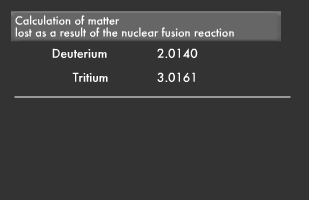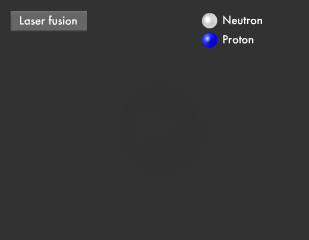Canon Science Lab
Laser Nuclear Fusion
The sun continues to shine and release energy because of nuclear fusion. Laser nuclear fusion involves the creation of what could be called an artificial sun through the use of laser beams.
Nuclear fusion is a reaction in which two atoms collide and combine to create a new atom. In the core of the sun, it is thought that hydrogen atoms cause nuclear fusion, transforming into helium atoms. (For details, see "Sunlight") Because the earth contains abundant hydrogen, discovering how to control nuclear fusion could lead to the creation of artificial suns as the ultimate energy source. The most easily accomplished fusion is between deuterium and tritium (two forms of heavy hydrogen), but even this is not at all simple, since sparking such a reaction requires a temperature of almost 100 million degrees. The use of lasers to trigger fusion events is one of methods currently being studied.
Enormous Energy is Released from Nucleus Reactions
E = mc2, the famous equation deduced by Albert Einstein from his Special Theory of Relativity, is a statement of the equivalence of energy and mass. It asserts that mass (m) can be completely converted into energy (E).
If one kilogram of material is completely converted into energy in accordance with this equation, it will generate the same vast amount of energy as would the burning of about three million tons of coal. The E = mc2 equation is actually used to calculate the amount of energy that could be generated from nuclear fission, fusion and other reactions between nuclei, which are the cores of atoms, and consist of protons and neutrons.

Mass Lost in a Reaction Becomes Energy
Today's nuclear power stations generate energy from the fission of uranium 235 nuclei, but work is in progress on fusion reactors that would be 10 times as efficient at generating energy from the nuclear fusion of deuterium and tritium.
When the nuclei of deuterium and tritium fuse, they transform into helium and neutrons, and the total mass is reduced by 0.38% through this reaction. In accordance with the E = mc2 equation, the lost mass is released as energy.

Fusing one kilogram of deuterium with tritium results in a loss of about one gram of mass, which is released as energy equivalent to about 3,000 tons of coal.
Using Powerful Lasers to Trigger Nuclear Fusion
Triggering nuclear fusion is not at all easy, but requires the satisfaction of all elements of "Lawson's criterion for fusion:" a temperature of over 100 million degrees; a "plasma" of naked nuclei in completely ionized state, with their electrons stripped; and the maintenance of an extremely high density of over 200 trillion nuclei per cubic centimeter for about one second.
Many different kinds of attempts have been made to meet Lawson's criterion, one of these being the focusing of powerful laser beam to cause an implosion at the core.

Researchers at Osaka University are investigating a method whereby powerful laser beams are focused from a device called the Gekko (from the Kanji characters for "laser") to a fusion fuel pellet capsule, triggering repeated momentary nuclear fusion events, and generating fusion energy from each event.
